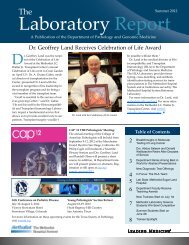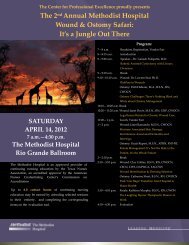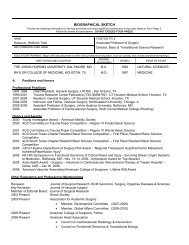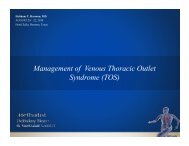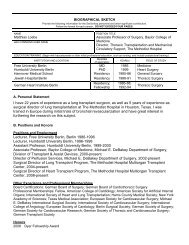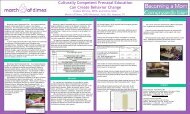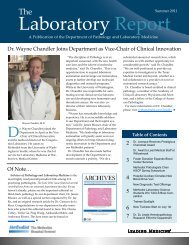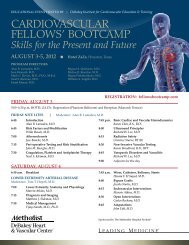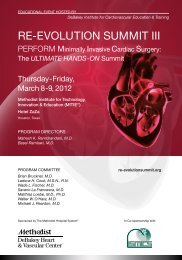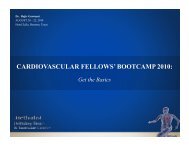DeBAKEy CARDIOvASCuLAR JOuRNAL - Methodist Hospital
DeBAKEy CARDIOvASCuLAR JOuRNAL - Methodist Hospital
DeBAKEy CARDIOvASCuLAR JOuRNAL - Methodist Hospital
You also want an ePaper? Increase the reach of your titles
YUMPU automatically turns print PDFs into web optimized ePapers that Google loves.
Figure 9. The Artery of Adamkiewicz identified by Dr. Sam Henly.<br />
Magnified virtual surgical table view inside Plato’s CAVE using<br />
Siemens flash CT scan study with TeraRecon, Inc. visualization.<br />
Figure 11. TeraRecon, Inc. visualization for planning the repair of<br />
esophageal varices that was more complicated than anticipated.<br />
additional information they gained from the 3-D visualization<br />
(Figures 8a and 8b).<br />
Some surgeons have used our visualization as an<br />
education tool for their patients (Figures 9 and 10). The<br />
surgeons are impressed with the quality of the visualization,<br />
the ease and speed with which positions of the<br />
images can be changed, the ability to strip away tissue<br />
that blocks the view of the subject tissue, the fact that<br />
no contrast agents are required to achieve the visualization,<br />
the saving of time, and the unexpected ancillary<br />
findings (Figures 11 and 12).<br />
On the other hand, some surgeons have said they<br />
do not see the need for such an environment because<br />
their experience overrides the real-time process and 3-D<br />
visualization that we provide, and that conventional<br />
imaging meets their needs. yet, these same surgeons<br />
admit that the CAvE would have great value for medi-<br />
Figure 10. The Artery of Adamkiewicz, identified by Dr. Sam Henly,<br />
on the virtual surgical table inside Plato’s CAVE using Siemens flash<br />
CTA scan with TeraRecon, Inc. visualization.<br />
Figure 12. Virtual surgical table view inside Plato’s CAVE using GE<br />
CTA scan study with TeraRecon, Inc. visualization for planning repair<br />
of esophageal varices.<br />
cal education because of its clarity and responsiveness<br />
for accurately viewing patient-specific images and associated<br />
disease.<br />
Clearly, N-dimensional visualization challenges<br />
current clinical practice paradigms. unlike many<br />
technological advances in science and medicine, the<br />
constraint on acceptance and adoption of Plato’s CAvE<br />
does not appear to be clinician resistance to change but<br />
rather the hospital’s need for 1) metrics that will satisfy<br />
institutional risk assessment requirements, and 2)<br />
an effective process for disseminating the innovation<br />
along with best practice standards and protocols that<br />
are accepted by the general clinical staff. We routinely<br />
ask surgeons, “When you review currently available<br />
CT or MR studies for pre-surgical planning, have the<br />
standard diagnostic imaging and viewing tools provided<br />
you with the confidence that your treatment plan<br />
MDCvJ | vII (1) 2011 31



